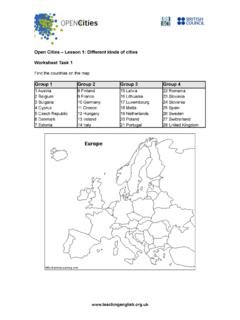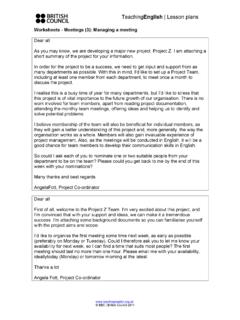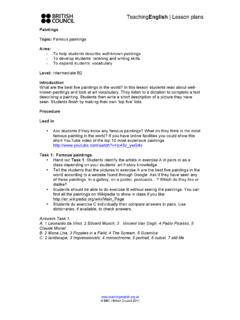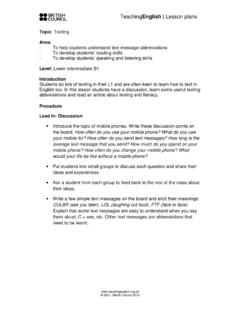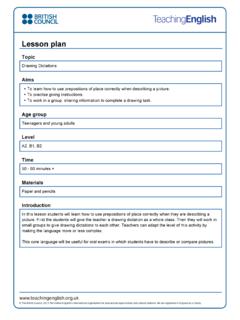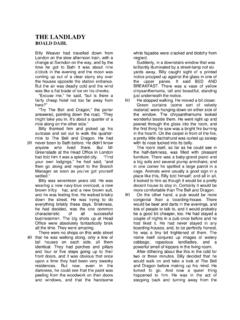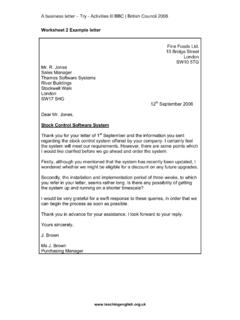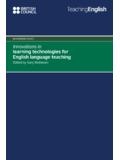Transcription of OPENCities – Lesson 2: Why do people migrate?
1 OPENC ities Lesson 2: Why do people migrate ? Topic: Human Migration Aims: To develop students' skills communication skills To develop students' vocabulary around the topic of human migration To help students understand some of the issues regarding human migration Level: Intermediate +. Introduction: This Lesson plan explores some of the issues associated with cultural and environmental adjustments and looks at some of ways in which these have impacted on the lives of migrants in different cities and countries. This is a strong underlying theme of the OPENC ities project Procedure To introduce the topic migration start by asking students a few questions: Have you ever been abroad? Would you like to live and work in another country? Why/why not? Do you know anyone who lives in another country? Why do people decide to live and work abroad? Where would you go if you decided to move to another country? Why? Encourage students to share their ideas and experiences.
2 Tip: This is a good time to listen to students and see what range of vocabulary they produce and where any gaps in their knowledge may be. Copy these letters and dashes onto the board and ask students if they can guess what the words are: (Answer: globalisation, trade, capital, movement). G_____. T____. C_____. M_____. If they can't guess, play a Hangman style game with the class, with four words instead of one and ask them to suggest letters that are missing from the words. Ask the students what they think these words mean and how they might be connected to the topic of migration. 16. Tech Tip: If you have a data projector and internet access, you can use http://. to find images and that show the associations between the words by typing them into the search or adding /search/ and the word you want to the URL. Example: +migration Quotations Hand out Worksheet Task 1 and ask the students to read the quotation and discuss the questions in pairs.
3 Tip: Your students may struggle a little with the quote so be prepared to help them understand it. Worksheet Task 1. Read this quotation and discuss the questions: .. it is impossible to separate the globalisation of trade and capital from the global movement of people . (The Economist, 2002). 1. Do you agree with it? Why/Why not? 2. What are the effects of the globalisation of trade and capital in our society? 3. What are the effects of the globalisation of people ? 4. Are there many people in your city who were born in another country? 5. How do people feel about foreign workers coming to your city? Once your students have had a chance to discuss the questions, give them the second quote and discuss it openly in class. Ask, Is this a lot of people who live abroad? Or is it a small amount? What do you think? . Of the billion people who populate the world, approximately 175-190. million live outside their country of birth. Personalisation task This exercise should get your students thinking and talking about the personal issues connected with migration.
4 Split your class into two groups and give group A one task and group B the other task from Worksheet Task 2. The students from each group should start by working alone to order the factors by importance. Then put them into smaller groups to compare and discuss their rationale for their order. Once the students have had time to compare with others from their group, regroup the students into pairs with one student from group A and one from group B. Ask them to discuss their tasks and their outcomes from the task, then decide which factors from each list most motivate people to migrate . 16. Finally ask them whether they think most migrants move countries for positive reasons (as in group A to improve their lives) or for negative ones (as in group B. to escape from negative factors). Worksheet Task 2. Task: Group A. Imagine you were moving to a new country. What would be the most important factors to take into consideration? Put these in order of importance.
5 Cinemas/theatres/concert halls Good flats/houses Good transport systems Good schools/hospitals/universities Presence of family/friends Safe streets Parks/green areas Free press and media Democratic system/equality Language Culture Other??? Task: Group B. Which of these things would most make you want to leave your home city or country? Unemployment Poor housing and services Poverty Famine War/unsafe social situation No job propects for your skills/qualifications Government persecution Discrimination Climate Geographical location Other?? 16. Speaking Ask students if they know anybody who has migrated to their town/country from another country or if they know someone who has moved from their country to another country. If any of the students do know someone, ask a few questions for a bit more information. Example: What do they do? Where did they go to / come from? Are they happy? Etc. Ask them to speak in small groups, sharing their ideas and experiences.
6 Give the students the pictures from Worksheet Task 3 and ask them to look at the pictures and discuss the questions with a partner or small group. Explain that if they do not know the answers they can speculate. Worksheet Task 3. Look at these pictures of people who have moved to another city. This is Miroslav This is Zhihong Image by Martin Fuchs Image by Veronica Vierin 16. This is Gip This is Chabela Image by Victoria Knysh Image by Markel Redondo This is Mamadou Image by Amy Chang Talk about these pictures: What do you think? What jobs do they do? Why did they move from their country of origin? What made them come to where they are now? Do you think they have better economic prospects where they live now? Why/why not? Are they happy where they are now? Do you think they will go back to their countries of origin? Once they have had some time to discuss the questions, ask for feedback from the students. Does everybody agree or do they have different ideas?
7 16. Listening task Tell students that they are going to hear the five people from the pictures talking about their experiences. Give them Worksheet Task 4. Tell them the first time they listen they should complete the sentences using the names of the cities and countries from the box. NB: If you don't have access to the audio files or the ability to play them, read or get students to read the audio scripts out loud in class Worksheet Task 4. Listen to the people speaking and complete the sentences using the countries and cities below. Senegal Dublin Dubai India Bolivia Serbia Bilbao Sofia Madrid China Austria Bulgaria 1. Miroslav is from _____ . He lives in _____ . 2. Zhihong is from _____ . He lives in _____ . 3. Gip is from _____ . He lives in _____ . 4. Mamadou is from_____ . He lives in _____ . 5. Chabela is from _____ . She lives in _____ . Answers: 1. Serbia + Austria 2. China + Ireland 3. India + Bulgaria 4. Senegal + Spain 5.
8 Bolivia + Spain When they have finished, check their answers together. Then ask them to listen again and complete these sentences using the names of one of the people . Which person .. 1. _____ is happy about the children being employed? 2. _____ works on a radio station? 3. _____ married someone from where they live? 4. _____ wants to settle down with a wife and daughter? Answers: Miroslav Mamadou Zhihong Zhihong 16. Speaking Put students into pairs or small groups and ask them to read the discussion questions through quickly to make sure they understand them. Then get students to discuss each question. Monitor the students and ask for a few opinions. Worksheet Task 5. In your opinion, which of these people .. has the best job? .. earns the most money? .. is very happy to live where they live? .. live in the city for professional reasons? .. live in the city for family reasons? .. would like to go back to their country of origin? Finally to round off the discussion, get some feedback and ask students why they think each person migrated.
9 Accept any reasonable ideas.. Tapescript I moved from Serbia to Austria 37 years ago. I moved to Vienna in 1985. I opened my own shop a delicatessen in 1991. My customers call me Michi. I've been working in the shop for 18. years. My son Sascha works with me now. My two daughters have got jobs too, so I am very happy. Things are working out very well for us here. (Miroslav Llic). people here call me Robert because they can't say or spell my Chinese name. After getting my degree in Computer Science I worked in lot of different places but never in Europe. I came to Dublin in August 2007 because I was offered a job in Microsoft. I like it here Irish people are very friendly to foreigners. I'm planning to stay here and settle down with my wife, who is also from China, and our daughter. (Zhihong). I was born in India, but I moved to Dubai with my parents when I was a baby. My wife is Bulgarian we met in Turkey, got married in the Bulgaran Embassy in Dubai, then went to live in Sophia.
10 I like the people here; I mean, me, being an Indian, and different colour, people look at me because they are curious to know where I am from, not because they are racist. (Gipi Gopinath). I'm from Senegal and I now live in Spain. I work for a non-profit organisation here in Madrid. We try to help new immigrants from Africa with nowhere to go. I also work with an internet radio station on a programme about multiculturalism and integration. (Mamadou). I'm from Bolivia but now I live in Bilbao in the Basque Country, in the north of Spain. I work for a Spanish family looking after an elderly person. I go to the old people 's home where Goya the person I look after lives. We walk around the residence if it is raining, or go out for a coffee if the weather is fine. I'v been looking afer Goya for four years now. (Chabela). ( Adapted from actual people in photo's words). 16. Role-play This activity gives the students the opportunity to imagine themselves as the immigrants in the images.
